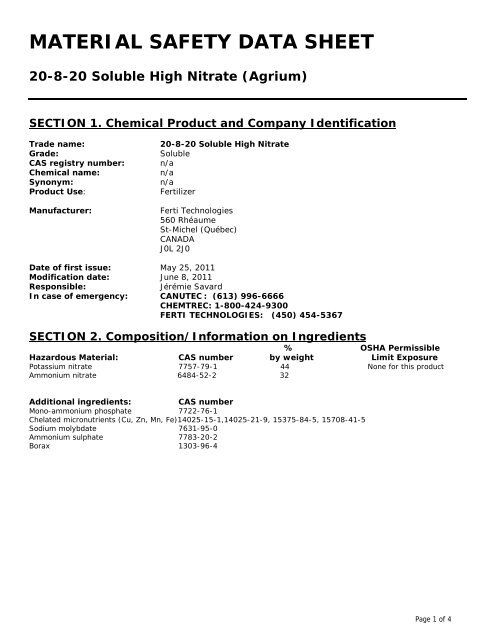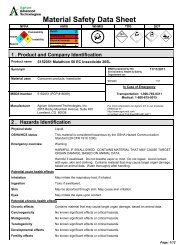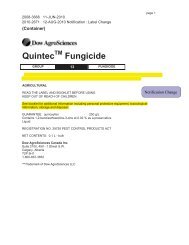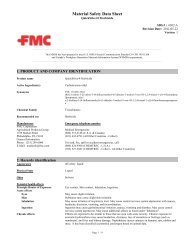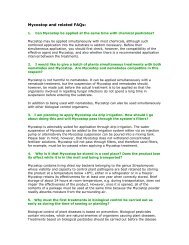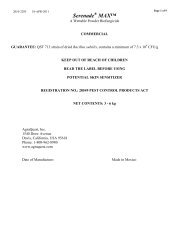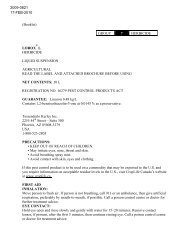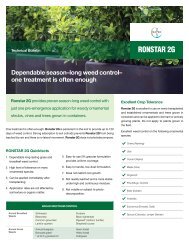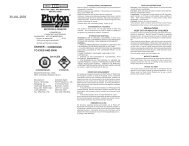20-8-20 High Nitrate soluble Agrium EN MSDS ANSI
20-8-20 High Nitrate soluble Agrium EN MSDS ANSI
20-8-20 High Nitrate soluble Agrium EN MSDS ANSI
Create successful ePaper yourself
Turn your PDF publications into a flip-book with our unique Google optimized e-Paper software.
MATERIAL SAFETY DATA SHEET<br />
<strong>20</strong>-8-<strong>20</strong> Soluble <strong>High</strong> <strong>Nitrate</strong> (<strong>Agrium</strong>)<br />
SECTION 1. Chemical Product and Company Identification<br />
Trade name:<br />
Grade:<br />
CAS registry number:<br />
Chemical name:<br />
Synonym:<br />
Product Use:<br />
Manufacturer:<br />
<strong>20</strong>-8-<strong>20</strong> Soluble <strong>High</strong> <strong>Nitrate</strong><br />
Soluble<br />
n/a<br />
n/a<br />
n/a<br />
Fertilizer<br />
Ferti Technologies<br />
560 Rhéaume<br />
St-Michel (Québec)<br />
CANADA<br />
J0L 2J0<br />
Date of first issue: May 25, <strong>20</strong>11<br />
Modification date: June 8, <strong>20</strong>11<br />
Responsible:<br />
Jérémie Savard<br />
In case of emergency: CANUTEC : (613) 996-6666<br />
CHEMTREC: 1-800-424-9300<br />
FERTI TECHNOLOGIES: (450) 454-5367<br />
SECTION 2. Composition/Information on Ingredients<br />
% OSHA Permissible<br />
Hazardous Material: CAS number by weight Limit Exposure<br />
Potassium nitrate 7757-79-1 44 None for this product<br />
Ammonium nitrate 6484-52-2 32<br />
Additional ingredients:<br />
CAS number<br />
Mono-ammonium phosphate 7722-76-1<br />
Chelated micronutrients (Cu, Zn, Mn, Fe)14025-15-1,14025-21-9, 15375-84-5, 15708-41-5<br />
Sodium molybdate 7631-95-0<br />
Ammonium sulphate 7783-<strong>20</strong>-2<br />
Borax 1303-96-4<br />
Page 1 of 4
SECTION 3. Hazards Identification<br />
<strong>20</strong>-8-<strong>20</strong> Soluble <strong>High</strong> <strong>Nitrate</strong><br />
Emergency overview: No significant immediate hazards for emergency responses are<br />
known.<br />
CAUTION:<br />
Contact with dust may cause discomfort and/or mild irritation to skin,<br />
eyes, nose and lungs. Avoid breathing dust.<br />
Do not ingest. May irritate mouth, stomach, etc.<br />
Wash thoroughly after handling.<br />
Physical state (25 0 C/77 0 F): Fine crystals or powder, blue, no odor.<br />
SECTION 4. First Aid Measures<br />
Inhalation:<br />
Bring subject to a well ventilated area. Contact a physician if symptoms<br />
persist.<br />
Skin:<br />
Wash with plenty of water.<br />
Eyes: Flush eyes with large quantities of running water for a minimum of 15<br />
minutes. Remove contact lenses. Rinse the entire surface of the eye and lid<br />
with water. Call a physician if eye irritation occurs.<br />
Ingestion:<br />
Harmfull if swallowed. Seek medical care. Do not induce vomiting.<br />
SECTION 5. Fire Fighting Measures<br />
Flammability limits in Air (%): n/a UEL: n/a LEL: n/a<br />
Fire extinguishing media: Use media appropriate to surrounding fire.<br />
Fire fighting procedures:<br />
Other fire or<br />
Explosion Hazards:<br />
Use a stream of water to cool containers and surfaces exposed to fire and<br />
to dissipate vapours. Use a self-contained respirator.<br />
Potassium nitrate causes or contributes to the combustion of another<br />
material yielding oxygen. Ammonium phosphate may act as fire retardant<br />
and may lower the combustion temperature of other material. Toxic gases<br />
may be released at elevated temperature.<br />
SECTION 6. Accidental Release Measures<br />
Small release:<br />
Release to water:<br />
Stop leak or spill. Collect for re-use. Contain runoff by diking. Prevent spills<br />
from entering water courses, basement or closed area. Wear appropriate<br />
personal protective equipment for cleanup.<br />
Reclaim as much product as possible to avoid further contamination.<br />
SECTION 7. Handling and Storage<br />
Handling:<br />
Storage:<br />
Wear suitable personal protective equipment. Avoid inhalation and<br />
prolonged or repeated contact with eyes and skin.<br />
Store in a dry, ventilated area, away from food and seed. Keep at ambient<br />
temperature.<br />
Keep out of reach of children.<br />
SECTION 8. Exposure Controls and Personal Protection<br />
Exposure limits:<br />
Personal protection:<br />
Respiratory:<br />
Ventilation:<br />
n/a<br />
Skin contact with the product should be prevented with the use of appropriate<br />
protective clothing and gloves (nitrile gloves are recommended). Wear safety<br />
glasses with side-shields to avoid eye contact.<br />
If dust is generated, use a NIOSH-approved respiratory mask.<br />
Provide good ventilation if dusty conditions prevails.<br />
Page 2 of 4
SECTION 9. Physical and Chemical Properties<br />
<strong>20</strong>-8-<strong>20</strong> Soluble <strong>High</strong> <strong>Nitrate</strong><br />
Physical state:<br />
Solid<br />
Appearance<br />
Fine crystals or powder, blue.<br />
Odour:<br />
No odor<br />
Melting point ( o C/ o F): n/a<br />
Bulk Density: 70-75lbs/ft 3 , 11<strong>20</strong>-1<strong>20</strong>0 kg/m 3<br />
Solubility: n/a g/ 100ml of water, at 70 o F (21 o C)<br />
pH:<br />
n/a<br />
SECTION 10. Stability and Reactivity<br />
Under Normal Conditions: Stable<br />
Under Fire Conditions: Stable<br />
Hazardous Polymerization: Will not occur<br />
Conditions to Avoid:<br />
Extreme temperatures<br />
Materials to Avoid:<br />
Strong oxidizing agents, chlorates, hypochlorites<br />
Hazardous Decomposition or<br />
Combustion Products: Cyanuric acid, sulfur oxides, ammonia, nitrogen oxides, carbon oxides<br />
SECTION 11. Toxicological information<br />
Recommended<br />
Exposure Limit:<br />
Toxicological Data:<br />
Carcinogenicity Data:<br />
Reproductive Effects:<br />
Mutagenicity Data:<br />
Teratogenicity Data:<br />
Synergistic Materials:<br />
Effects of exposure when<br />
Inhaled:<br />
In contact with the skin:<br />
In contact with the eyes:<br />
Ingested:<br />
Other health effects:<br />
None recommended for this product<br />
None known<br />
Ingredients of this products are not listed as carcinogens by OSHA or NTP<br />
and are not rated by IARC or ACGIH.<br />
No data available<br />
No data available<br />
No data available<br />
None known<br />
Dust is irritating to nose, throat and respiratory tract. May cause coughing<br />
or sneezing.<br />
Prolonged and repeated contact may cause mild irritation.<br />
Dust may cause mild irritation and due to abrasiveness may cause eye<br />
damage if untreated.<br />
Ingestion may cause gastrointestinal upset, abdominal pain and diarrhea.<br />
<strong>High</strong> concentration of urea in the blood increases the risk of glaucoma.<br />
SECTION 12. Ecological information<br />
May be harmful to aquatic life. In sufficient quantity may deplete oxygen required by aquatic life. May cause<br />
eutrophication of ponds and lakes.<br />
Deactivating chemical:<br />
None required<br />
SECTION 13. Disposal considerations<br />
Suitable for use as agricultural/horticultural fertilizer. Consult local authorities. Do not dispose of waste<br />
with normal garbage or into water systems.<br />
Page 3 of 4
SECTION 14. Transport Information<br />
<strong>20</strong>-8-<strong>20</strong> Soluble <strong>High</strong> <strong>Nitrate</strong><br />
DOT/TDG Classification<br />
UN <strong>20</strong>71- Class 9 - PG III (Ammonium nitrate fertilizers)<br />
SECTION 15. Regulatory Information<br />
NFPA<br />
Classification<br />
DOT/TDG<br />
Pictogram<br />
WHMIS<br />
Classification<br />
Protective<br />
clothing<br />
DOT/TDG<br />
Health hazard:1(Slightly<br />
hazardous)<br />
Fire hazard: 0 (Above 93 o C/<strong>20</strong>0 o F)<br />
Instability hazard: 1 (May react)<br />
Specific hazard: None<br />
Class C<br />
Oxidizing<br />
substances<br />
SECTION 16. Other Informations<br />
References :<br />
Commission de la santé et de la sécurité au travail, http://www.reptox.csst.qc.ca<br />
United States Department of labor, Occupational Safety and Health Administration,<br />
http://www.osha.gov/<br />
Report on Carcinogens, Eleventh Edition; U.S. Department of Health and Human Services,<br />
Public Health Service, National Toxicology Program.<br />
http://ntp.niehs.nih.gov/index.cfm?objectid=32BA9724-F1F6-975E-7FCE50709CB4C932<br />
List IARC Carcinogenic Agents <strong>20</strong>10, International Agency for Research on Cancer,<br />
http://monographs.iarc.fr/<strong>EN</strong>G/Classification/Listagentsalphorder.pdf<br />
Definitions of abbreviations:<br />
ACGIH<br />
American Conference of Governmental Industrial Hygienists<br />
CAS<br />
Chemical Abstract Service<br />
DOT<br />
Department of Transportation<br />
IARC<br />
International Agency for Research on Cancer<br />
LEL<br />
Lower Explosive Limit for Flammable Gases and Vapor<br />
NFPA<br />
National Fire Protection Association<br />
NIOSH<br />
National Institute for Occupational Safety and Health<br />
NTP<br />
National Toxicology Program<br />
OSHA<br />
Occupational Safety and Health Administration<br />
TDG<br />
Transport of Dangerous Goods<br />
UEL<br />
Upper Explosive Limit for Flammable Gases and Vapor<br />
WHMIS<br />
Workplace Hazardous Materials Information System<br />
NOTICE:<br />
The information presented herein is based on data considered to be accurate as of the date of preparation<br />
of this document. However, no warranty or representation expressed or implied, is made<br />
to the accuracy or completeness of the foregoing data and safety information.<br />
Page 4 of 4


